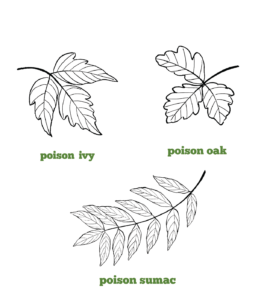When your kids are out enjoying the best days of summer, it’s hard to keep them out of the weeds, creeks and woods. Educate them about harmful ivies, plus, keep in mind more safety precautions:
- Explain what the poisonous plants look like and remind them to avoid them.
- If they have been exposed, have them change their clothes after they come inside; be mindful that oil can stay on clothing, under nails and on pets for days.
- Wash their body with soap and water within an hour of exposure. • Although you cannot transmit ivies to others from your lesions, others can get a rash from the plant oil, meaning you can get it from your pet’s fur.
- Trim nails to prevent further damage from the inevitable itching
Ivy: A three-leafed green weed with a red stem at the center. It grows like a vine and the leaves turn red in the fall.
Oak: It has three leaves but grows as a shrub usually, not a vine. It is less common than poison ivy.
Sumac: It often forms seven to 13 leaflets arranged in pairs along a central stem. It’s typically a shrub, not a vine. It grows mostly in the swampy areas.
Hemlock?
You have heard about it, or have mistaken it for a harmless weed. Poison Hemlock is a poisonous plant, which resembles Queen Anne’s Lace or wild fennel, and has been making its way all over the state, including in southwest Ohio and the Cincinnati region.
With this harmless-looking plant popping up in places such as parking lots and your backyard, it’s extremely important to know what it looks like, how to handle it and to keep your kids clear of its path, because it can be harmful to humans just as much as animals.
“Poison hemlock has white flowers with an umbrella shaped head,” explains Doll. “The leaves are green and fern-like, the white flowers eventually turn into a green, deeply ridged fruit. It grows between four to 10 feet tall. Typically, the leaves and stem are not hairy, and the stem has small purple spots.”
All parts of the hemlock plant are poisonous, including the roots, but one can only become poisoned by ingesting it, she continues. Now that you know what it looks like, now what? You can remove hemlock without being exposed by wearing protective gloves and clothing and then immediately washing your hands and body, as small parts of the toxin can be absorbed by rubbing your eyes or touching your mouth, says Doll.
Very importantly, never burn the plant because it can release dangerous toxins in the air and adding it to your compost pile is also a big no. Talk to your kids and family about hemlock and remind them to avoid it. If your kids see the white flowery plant, tell them to walk away from it and tell you immediately. The safest thing you can do is call a local agency to help remove it. If your kids (or you) are exposed, contact poison control right away and look out for these symptoms, says Doll: dilation of pupils, trembling, dizziness, and slow heartbeat. These are all related to poisoning which means you should go to your nearest medical facility to receive care.
Sources: USDA agricultural Research Services and healthychildren.org






